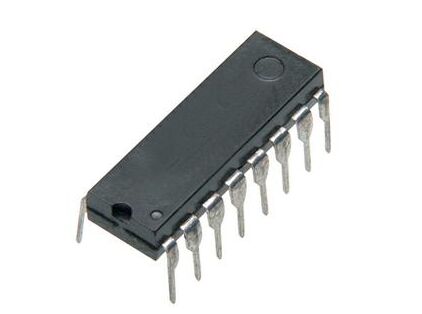A 330 ohm resistor is a type of resistor with a resistance value of 330 ohms. Here are some key points about a 330 ohm resistor:
.jpg)
-
Resistance Value: A 330 ohm resistor restricts the flow of electric current in a circuit. It is designed to provide a specific amount of resistance, measured in ohms, to control the current flow according to Ohm's Law (V = I * R), where V is voltage, I is current, and R is resistance.
-
Tolerance: Like other resistors, a 330 ohm resistor may have a specified tolerance that indicates the maximum allowable deviation from the nominal resistance value. Common tolerance values for resistors include 5%, 1%, and others.
-
Power Rating: The power rating of the resistor specifies the maximum amount of power it can dissipate without getting damaged. The power rating is typically specified in watts and depends on the resistor's construction and material.
-
Color Coding: In through-hole resistors, the resistance value and tolerance are often indicated by colored bands. The color code for a 330 ohm resistor typically includes specific colors representing digits and a tolerance band.
-
Applications: A 330 ohm resistor can be used in various electrical and electronic circuits for purposes such as current limiting, voltage division, signal conditioning, biasing components in circuits, filtering, and other applications where precise resistance values are required.
-
LED Limiting Resistor: A 330 ohm resistor is commonly used in series with LEDs to limit the current flowing through them and protect the LEDs from damage due to excessive current.
Overall, a 330 ohm resistor is a standard electronic component that finds application in many types of circuits to control current flow, divide voltages, set biasing conditions, and perform other functions that involve the use of resistors with specific resistance values.
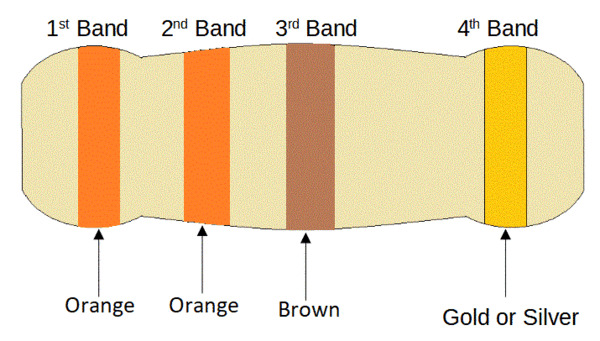
The 330 Ohm Resistor Color Code
For a 330 ohm resistor, the resistor color code typically consists of four color bands that denote the resistance value and tolerance. Here is how you can interpret the color bands for a 330 ohm resistor:
- Orange: 3 (first digit)
- Orange: 3 (second digit)
- Black: 0 (multiplier)
- Gold: Tolerance of +/- 5%
Therefore, in a standard 4-band resistor color code scheme:
- First band (3): Orange
- Second band (3): Orange
- Third band (0): Black
- Fourth band (Multiplier - Ohms): Gold
- Fifth band (Tolerance): Gold
This color code indicates that a resistor with orange, orange, black color bands and a gold tolerance band would have a resistance value of 330 ohms with a tolerance of +/- 5%.
330 Ohm Resistor Color Bands
For a 330 ohm resistor, the color bands would be as follows in a standard 4-band resistor color coding system:
- Orange (3rd band): First digit
- Orange (3rd band): Second digit
- Black (0s = 10^0): Multiplier
- Gold (± 5%): Tolerance
Therefore, the color bands for a 330 ohm resistor would be:
- Orange
- Orange
- Black
- Gold
In summary, a resistor with these color bands would have a resistance value of 330 ohms with a tolerance of ± 5%.
330 Ohm Resistor Color Chart
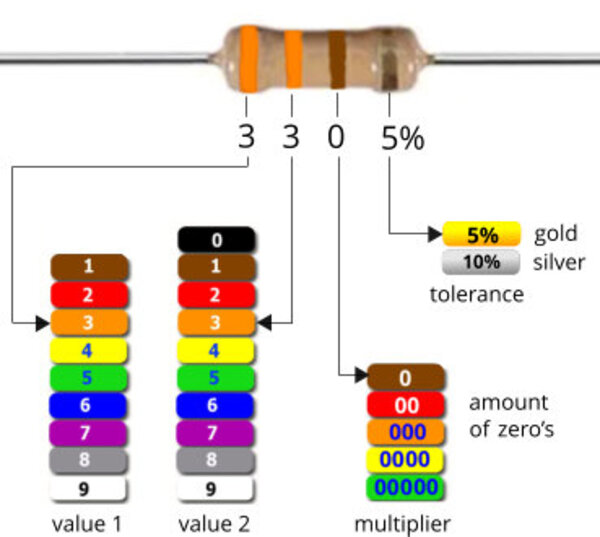
Here is the color chart for a 330 ohm resistor in a 4-band color code system:
- Band 1 (1st Band): Orange
- Band 2 (2nd Band): Orange
- Band 3 (3rd Band): Brown
- Band 4 (4th Band): Gold
Therefore, an orange, orange, brown, gold resistor corresponds to a resistance value of 330 ohms with a tolerance of +/- 5%.
How To Read the 330 Ohm Resistor Color Code
To read the color code of a 330 ohm resistor, follow these steps:
-
Identify the Color Bands: A 330 ohm resistor typically has four color bands. Each color represents a specific value:
- Band 1: First digit of the resistance value.
- Band 2: Second digit of the resistance value.
- Band 3: Multiplier (power of 10).
- Band 4: Tolerance.
-
Interpret the Colors:
- Orange: 3 (first digit)
- Orange: 3 (second digit)
- Brown: 10^1 (multiplier)
- Gold: Tolerance of +/- 5%
-
Calculate the Resistance Value using the color codes:
- First digit (Orange): 3
- Second digit (Orange): 3
- Multiplier (Brown): 10^1 (10)
Resistance = (Digit 1 * 10 + Digit 2) * 10^Multiplier = (3 * 10 + 3) * 10^1 = (30 + 3) * 10 = 330 ohms
-
Consider the Tolerance:
- Gold band indicates tolerance of +/- 5%. This means the actual resistance could vary by 5% from the stated value of 330 ohms.
By following these steps and understanding the color code chart, you can determine that an orange-orange-brown-gold resistor corresponds to a 330 ohm resistor with a tolerance of +/- 5%.
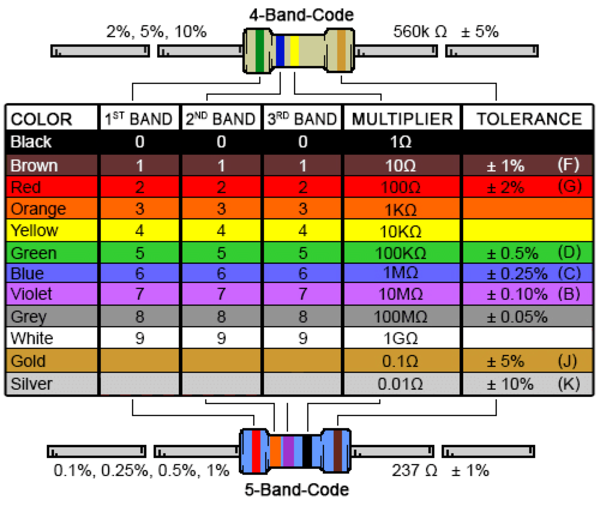
4-Band vs. 5-Band vs. 6-Band 330 Ohm Resistor Color Code
When comparing the 4-band, 5-band, and 6-band color codes for a 330 ohm resistor, here is how the color bands would be represented in each system:
4-Band Resistor Color Code:
- Orange-Orange-Brown-Gold:
- First digit: 3
- Second digit: 3
- Multiplier: 10^1 (10)
- Tolerance: +/- 5%
- This represents a standard 330-ohm resistor with a tolerance of +/- 5%.
5-Band Resistor Color Code:
- Orange-Orange-Brown-Black-Gold:
- First digit: 3
- Second digit: 3
- Third digit: 0
- Multiplier: 10^1 (10)
- Tolerance: +/- 5%
- The 5-band code adds an additional significant digit for improved precision.
6-Band Resistor Color Code:
- Orange-Orange-Brown-Black-Black-Gold:
- First digit: 3
- Second digit: 3
- Third digit: 0
- Multiplier: 10
- Tolerance: +/- 5%
- A 6th band might be added for a temperature coefficient.
In summary, the choice between a 4-band, 5-band, or 6-band resistor color code system depends on the level of precision and additional specifications required for the application. The number of bands indicates the level of detail and accuracy provided in the resistor's color coding.
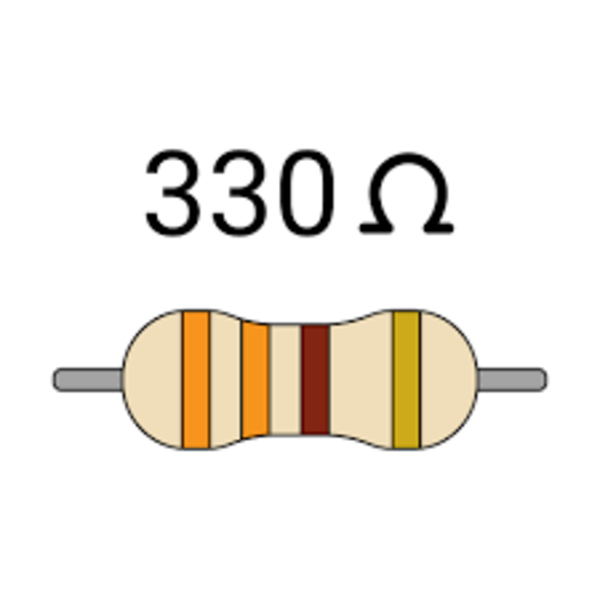
Applications of 330 Ohm Resistor
A 330 ohm resistor, like other resistors, finds a range of applications in electronics and electrical circuits due to its specific resistance value. Here are some common applications of a 330 ohm resistor:
-
LED current limiting: One of the most common applications is to use a 330 ohm resistor in series with an LED to limit the current passing through the LED, thereby protecting it from damage due to excessive current.
-
Voltage dividers: 330 ohm resistors can be used in voltage divider circuits to create reference voltages, level shifting, or biasing for transistors and integrated circuits.
-
Pull-up or pull-down resistors: In digital circuits, 330 ohm resistors can be used as pull-up or pull-down resistors to ensure that a signal is at a defined logic level when no other active device is driving the signal.
-
Biasing circuits: They are commonly used in biasing circuits for transistors and operational amplifiers to set the operating points of these components.
-
Current limiting: In various applications, a 330 ohm resistor can be used to limit the current flow in a circuit to prevent damage to components or to control the performance of the circuit.
-
Filter networks: These resistors can be used in conjunction with capacitors to form filter networks for noise reduction or signal conditioning.
-
Voltage regulation: They can be employed in voltage regulator circuits to stabilize the output voltage of power supplies.
-
Audio applications: In audio circuits, 330 ohm resistors are used for impedance matching, load balancing, and signal attenuation.
-
Timer circuits: In combination with capacitors, they can be used in timer circuits, oscillators, and pulse generation circuits.
-
In-series or in-parallel configurations: A 330 ohm resistor can be used in series or parallel configurations in various electronic designs to achieve specific performance characteristics.
These are just a few examples of how a 330 ohm resistor can be used in different electrical and electronic circuits. The versatility of resistors allows them to be applied in a wide range of applications to control current, voltage, and signal levels within a circuit.
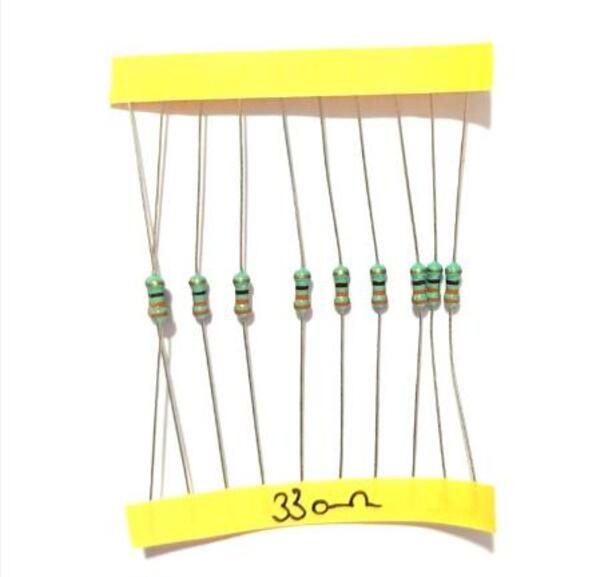
Why do We Use a 330 ohm Resistor to Connect a LED?
A 330 ohm resistor is commonly used to connect an LED in a circuit for the following reasons:
-
Current Limiting: LEDs are current-driven devices, meaning they require a specific amount of current to operate within their safe operating range. Without a current-limiting resistor, an LED can draw too much current from the power source, potentially leading to overheating and premature failure. The 330 ohm resistor limits the current flowing through the LED to a safe level.
-
Prevents LED Damage: Applying too much current to an LED can damage or destroy it. By using a 330 ohm resistor in series with the LED, the resistor restricts the current flow, preventing the LED from getting damaged due to excessive current.
-
Voltage Matching: LEDs require a specific forward voltage drop to turn on and emit light. The forward voltage drop across an LED differs from the voltage supply of most circuits. The 330 ohm resistor helps match the forward voltage drop of the LED to the supply voltage, ensuring proper operation.
-
Maintains Consistency: Using a 330 ohm resistor for LED connections provides consistency in the current flowing through multiple LEDs in a circuit. This helps ensure uniform brightness and performance across all connected LEDs.
-
Standard Value: The 330 ohm resistor is a commonly available standard resistor value that works well for many typical LED applications. It provides a good balance between current limiting and brightness for different types of LEDs.
-
Simplicity and Ease of Application: Using a 330 ohm resistor simplifies the design process for connecting LEDs, as it is a straightforward and widely accepted solution for ensuring proper current flow and protecting the LED.
In summary, a 330 ohm resistor is used with LEDs to limit current, prevent damage, match voltage levels, ensure consistent performance, and simplify the design of LED circuits. It plays a crucial role in protecting the LED and ensuring optimal operation within a circuit.


